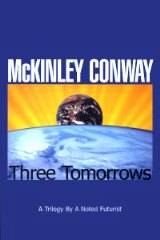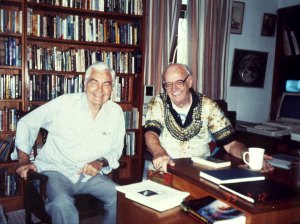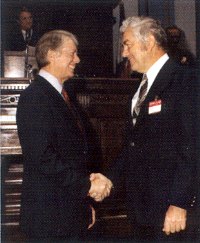|
Week of February 2, 2004 Special Report |
|
LOOKING FOR A PREVIOUS STORY? CHECK THE ARCHIVE.
Book Review Site Selection Publisher Conway Writes Novelistic Trilogy, Three Tomorrows
 Site Selection Publisher Mac Conway has added yet another role to his long and multi-faceted resume: novelist.
Site Selection Publisher Mac Conway has added yet another role to his long and multi-faceted resume: novelist.
Conway has written a book, Three Tomorrows, that in reality is actually three books in one. (It's available at both www.amazon.com and www.conway.com.) The trilogy's three parts include Miracles of Megamind, a glimpse of the future in the year 2000 (which was published earlier), as well as two brand-new novels: • Rivers of Peace, a glimpse of the future in 2025. • Galaxies of the Mind, a glimpse of the future in 2050. Three Tomorrows' focus on the future strongly echoes much of Conway's work (including two dozen previous non-fiction books). He has long argued, in fact, that futurism is an essential element in every professional's repertoire of skills.
Through tales of adventurous derring-do, Three Tomorrows unfolds a broad and thought-provoking tapestry of potential future events. A sampling of some of Conway's challenging future possibilities includes: • The creation of great new rivers of good, potable water, reviving desert areas and rescuing many nations from centuries of war and poverty; • The discovery of a genome that wipes out the cocaine industry; • The building of a great new global highway that links more than 100 nations; • A highly powerful nano-camera that's so tiny that it can be inserted, undetected, into a contact lens; and • A dog-language translator and even a "dog talk show" on television.
"The reader," Conway writes in his introduction, "will quickly discover that I am not a skilled or veteran novelist. However, I have spent a lifetime producing forecasts for non-fiction publications. "Some of the suggested scientific breakthroughs will be ridiculed by experts," he allows. "My response is to point to Dick Tracy's wrist radio described nearly a century ago, or to our talented friend Arthur Clarke's proposal for satellite communication, published decades before it became a reality." Author's Life Rife with Examples of
That response underscores a recurrent theme throughout Conway's distinguished career: perceiving future realities well before others can.
First Seeing, Then Shaping, the Future His early work with NACA/NASA, for example, included the 1948 paper, "Control of Airplane Flight Path By Propulsive Jets," which introduced the concept of using rotatable nozzles and/or control vanes to direct jet- and rocket-engine thrust. NASA later adopted that design idea for its spacecraft. And now the concept is being applied to new fighter aircraft. Conway's future-oriented outlook continued after he left NASA to become the first director of the 15-state Southern Association of Science and Industry. There, he formulated and developed a regional strategy for establishing research centers and developing high-technology industries. The effort helped lift the South from a poverty-stricken agricultural area to a world-leading region in economic development.
Similarly, the Three Tomorrows trilogy describes a host of major development strategies that dramatically improve the quality of life in many global regions. Trilogy Reflects Conway's Pioneering
Conway strongly continued the theme of future-looking development in 1954, when he founded and published the first-ever magazine to focus on corporate real estate and economic development. It was called Industrial Development. Seven years later, Conway decided to give his magazine a new name, Site Selection.
Work in Development and Real Estate As Site Selection observed in its January 2004 50th-anniversary issue, "When the history of 20th-century corporate real estate and economic development is written and capped, one name will stand out for his legacy: McKinley Conway." After creating his magazine, Conway then rapidly advanced to tackling industry-wide concerns. In 1961, he founded the International Development Research Council (IDRC), an association of corporate real estate executives. For the next four decades, he led what would come to be a trailblazing organization. In particular, IDRC was a catalyst in transforming corporate real estate from its early days as a secretive "boys-in-the-back-room" profession. Instead, Conway and IDRC brought sound principles to bear on the field like science, research and environmentalism. Real estate began its steady evolution from a back-room necessary evil to a key element in corporate strategic planning.
Conway continued that progressive industry-wide thinking in 2002, founding the Industrial Asset Management Council (IAMC at www.iamc.org). Fast-growing IAMC has quickly carved out a strong and unique niche, focusing on industrial- and manufacturing-sector executive-level managers who're responsible for corporate real estate and asset management. In 1991, Conway also founded the World Development Federation and chaired Global Super Project Conferences in Barcelona, Honolulu, Madrid, Osaka, Singapore and Paris during the 1990s. Again, Conway's factual life is mirrored in his fictional content. Three Tomorrows also focuses on large and venturesome development projects, with particular attention to major new infrastructure projects that better the lives of millions. (The World Development Federation even appears in fictionalized guise in the trilogy.) Technology Permeates Trilogy
Three Tomorrows also continues Conway's long and strong focus on technology. For example, all the way back in 1983, he created SiteNet, a cyberspace landmark. SiteNet was the first-ever electronic network devoted to corporate real estate and economic development.
Technology in many forms appears frequently in Three Tomorrows. Some readers will likely see parts of Conway's envisioned technological future as more readily understood extensions of today's realities. But other aspects of Conway's projected techno-tomorrows may well baffle some readers. Such unpredictability, however, is a recurrent reality in how technology actually develops. Conway convincingly made that case, non-fictionally, in his 1992 book, A Glimpse of the Future: Technology Forecasts for Global Strategists. A former member of the Georgia Senate, Conway also looks at what the geo-political future may hold. Three Tomorrows describes not-yet envisioned bodies that better govern global society. In addition, he looks at ways to confront and control the rogue nations and terrorists that almost certainly will continue to threaten the world order. And, as you might expect, the protagonists created by Conway, a licensed pilot for 65 years, spend a lot of time in the air. "Much of our fiction may never be anything but fiction," Conway writes. "However, lurking somewhere in these laborious texts might just be a true gem of a prediction."
©2004 Conway Data, Inc. All rights reserved. Data is from many sources and is not warranted to be accurate or current.
|



